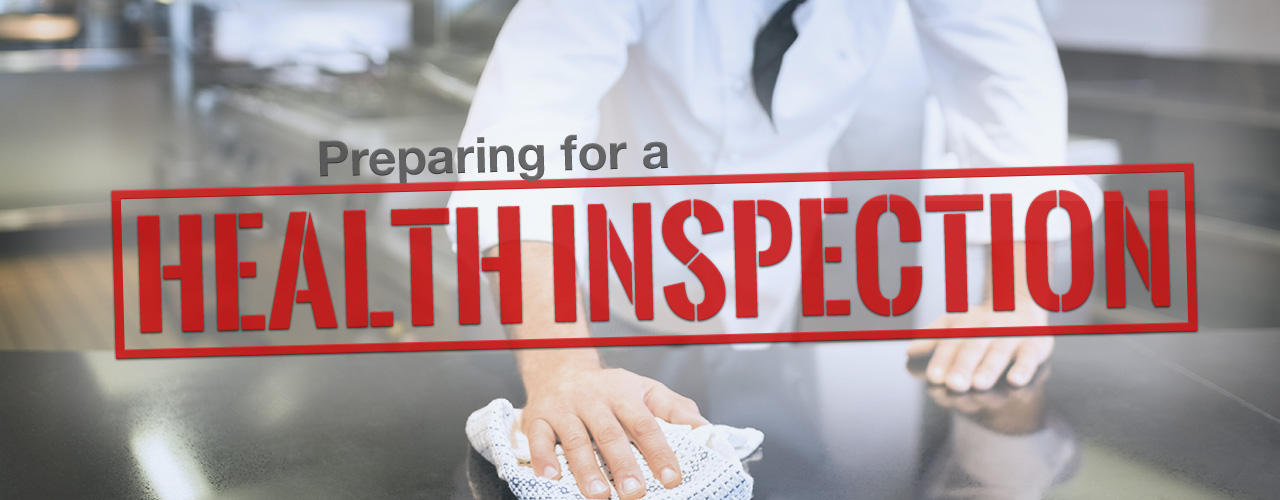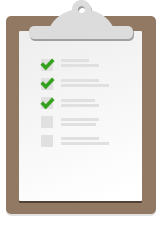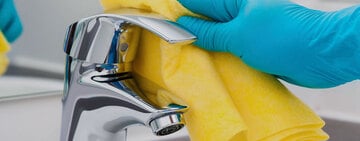
Health inspections can be a frustrating and stressful experience, but it’s important to remember that health inspectors don’t come looking to shut down your operation. Health inspections are held to make sure food products are handled and prepared according to state and local regulations to protect the public. We created a restaurant health code checklist for you to follow so you can feel prepared for your next inspection.
How to Prepare for a Health Inspection
Ensure that your restaurant is ready for an inspection by brushing up on your foodservice industry knowledge and regulations. Here are some tips to help you prepare for your next inspection.
- Review your HACCP Plan. One tool to prepare for a health inspection is a HACCP (Hazard Analysis and Critical Control Points) plan. The HACCP system identifies the points in the cooking process where the risk of contamination is the greatest. Once the hazards have been identified, you can take action to prevent possible contamination.
- Familiarize yourself with common health code violations. Always keep an eye out for key safety issues and common restaurant health code violation, including cross-contamination, personal hygiene, and internal temperature requirements.
- Consult your local health department. Find out what regulations and health inspection forms are being used so that you know exactly what they'll be looking for.
- Conduct self-inspections at random, unannounced times. Health inspections can occur at any time, so all of your employees must be equally prepared. After your self-inspections, review the results with your employees and discuss the corrective actions for any possible violations.
- Quiz your employees. Ask employees safety questions about tasks they're performing to ensure they're prepared for any inquiries that might come from the health inspector. For example, ask them what color food storage containers they should store poultry, seafood, and vegetables in to prevent cross-contamination.
- Stay up to date. Continue to monitor food preparation and storage, even after your self-inspection. Keep your managers updated on the latest food safety developments so that they can ensure compliance when you're not around.
Health Inspection Checklist
Here are some things to look out for during your restaurant’s self-inspection. You can see the full printable restaurant inspection checklist by clicking the button below:
Download Health Inspection Checklist PDF
Food Storage
- Food is kept at least 6” off the ground.
- Chemicals and food are separated.
- Food is stored in a clean, dry location that is not exposed to contamination.
- Food is stored using the FIFO (First In, First Out) method.
Freezer and Refrigerator Maintenance
- Thermometer is easily visible and displays the correct temperature.
- Food is stored at least 6” off the ground in walk-in refrigerators.
- Refrigerators and freezers are clean.
- All food items are correctly labeled and dated.
Food Preparation
- Food is protected from cross-contamination.
- Frozen food is thawed properly in a refrigerator or under running water.
- Staff uses gloves, clean hands, or utensils when handling food.
- Food is heated to the correct temperature to remove all bacteria before being placed in the hot holding area.
Sanitation
- Washing station is organized into three sections for washing, rinsing, and sanitizing.
- Equipment is clean to sight and touch.
- Utensils are covered to protect them from dust and contaminants when stored.
- Water temperature is heated to the correct temperature for sanitizing.
Refuse and Garbage Disposal
- Garbage and refuse is properly disposed of. Outside receptacles have lids or covers.
- Garbage and recycling bins are emptied when full.
- The area around the dumpster is clean and free of pests.
- Garbage bins are cleaned regularly to prevent pests.
Employee Hygiene
- Employees wear hairnets, and male employees cover facial hair.
- Eating and smoking are limited to designated areas away from food prep areas.
- Employees wash their hands regularly using proper hand-washing techniques.
- Employees wear clean clothes and proper, closed-toed shoes.
What to Do During a Health Inspection
When it comes time for your official health inspection, there are some things you should and should not do while the inspector is on premise.
Do...
- Verify the inspector's credentials. The inspector should offer this to you voluntarily, but if they don't, ask. If you're still not sure, call your local health department for verification to avoid being scammed by someone looking for free business information.
- Follow the inspector so that you can see any restaurant violations first-hand. It is important to note that you can correct some violations on the spot. These violations will be recorded as fixed on the spot, but to potential customers that is more appealing than an out of compliance mark.
- Sign the inspection report. This does not indicate that you agree with the findings, but it is instead evidence that you received a copy.
- Ask for an explanation if you don't understand a violation. You can't correct the problem if you don't know what it is.
Do Not...
- Refuse an inspection. That will only delay things as the inspector will return shortly with an inspection warrant and likely a less than pleasant attitude.
- Offer the inspector any food or beverage. Be cordial and pleasant, but anything beyond that could be misinterpreted as bribery to influence the inspection report.
What to Do After a Health Inspection
After the restaurant health inspection is completed, your operation will be given a score. If you were following the inspector during your inspection, your score should not come as a surprise. In order to understand your score and its effect on your business, you should learn about the restaurant scoring systems. Once you understand your score, you can begin to fix any possible violations.
Understanding Health Inspection Scores
There are two main restaurant grading systems: points-based systems and letter grade systems. Which system is used depends on the local or state health department that is conducting the inspection. Health violations in restaurants are categorized as critical and non-critical or as high-risk and low-risk depending on the department.
Points-Based Systems
Points-based systems are usually scored on a 100 point scale. Health inspectors determine your food inspection score by the number and severity of the violations.
| Score | Condition | Violations |
|---|---|---|
| 90 or higher | Good | One or two low-risk violations May have one high-risk violation |
| 80-89 | Adequate | Several low-risk violations May have one high-risk violation |
| 70-79 | Needs Improvement | Multiple low- and high-risk violations |
| 69 or lower | Poor | Many low- and high-risk violations |
Letter Grade Systems
Letter grade systems are usually scored as A, B, or C to represent the restaurant’s food regulation compliance. In most cases, inspectors tally up points depending on the number and the severity of the health code violations in restaurants and then convert the number to a letter grade. The letter grade system is intended to simplify the scores, so they are easily understood by consumers.
| Letter Grade | Condition | Violations |
|---|---|---|
| A | Good | Few or zero low-risk violations May have one high-risk violation |
| B | Adequate | Multiple low- and high-risk violations |
| C | Needs Improvement / Poor | Many low- and high-risk violations |
Correcting Health Code Violations
Poor health inspection results can be damaging to your business, especially because it is now easier for customers to find and understand health inspection violations. If your establishment has several low-risk or any high-risk violations, here are some steps you can take to fix your violations:
- If your establishment receives a poor health inspection score, you can schedule a re-inspection in 5 - 45 days. This will give you time to correct the violations.
- Figure out how each violation occurred and how you can prevent it from happening again.
- Just like with your own self-inspection, review any violations and their proper corrective action with your staff.
- You may appeal a violation if you have reason to disagree with it. Call your local health department, so you can speak with the inspector's supervisor.
Back to Top
Some operators approach health inspections with anxiety or frustration, but health inspections are potential learning opportunities that are meant to reduce the spread of food-borne illnesses and ensure the safety of your customers. There are many steps you can take to prepare your establishment for your restaurant health inspection, such as training employees to avoid health code violations, knowing your local food codes, becoming ServSafe certified, and conducting self-inspections.




